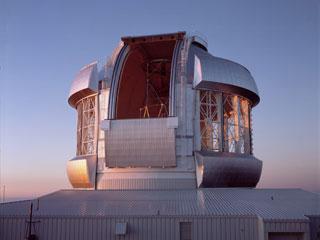
The researchers used the Gemini North telescope in Hawai for their study. Photo: Neelon Crawford, Polar Fine Arts.
WASHINGTON (PTI): Radiation from black holes can push away the gas they feed on, a new study has revealed, explaining why black holes go quiescent.
An international team, led by University of Sydney, has found that a black hole creates a "wind" which pushes its own "food" of dust and gas out of reach, using Gemini North telescope in Hawaii.
According to them, this is the process that turned actively feeding black holes -- common in the early universe -- into the quiescent ones found in galaxies today.
"It looks like they've found the 'off switch' for black holes. We've long suspected that a negative feedback process like this must be at work, but these observations are the first clear evidence of outflows that can starve a black hole of fuel," lead astronomer Prof Joss Bland-Hawthorn said.
The astronomers studied the galaxy Markarian 231, which lays 600 million light years away.
Markarian 231 is a "train wreck" resulting from the collision of two galaxies. At its centre is a black hole at least ten million times the mass of the Sun, which is sucking in gas and dust from its immediate surroundings.
The black hole in Markarian 231 was known to produce narrow jets but the Gemini observations have revealed a broad outflow extending in all directions for at least 8000 light years around the galaxy's core.
More than one physical process is likely to be creating the outflow. One is thought to be the X-rays and gamma rays generated around the black hole, which heat up the gas in the galaxy's centre until it "boils over".
Gas is streaming away from the galaxy's centre at speeds of over 1000 kilometres a second -- fast enough to travel from Sydney to Perth in four seconds. The flow is sweeping away huge amounts of gas.
"The fireworks of new star formation and black hole feeding are coming to an end, most likely as a result of this outflow," team member Dr David Rupke of Rhodes College in the US said.
 Previous Article
Previous Article Next Article
Next Article













The Indian Air Force, in its flight trials evaluation report submitted before the Defence Ministry l..
view articleAn insight into the Medium Multi-Role Combat Aircraft competition...
view articleSky enthusiasts can now spot the International Space Station (ISS) commanded by Indian-American astr..
view article